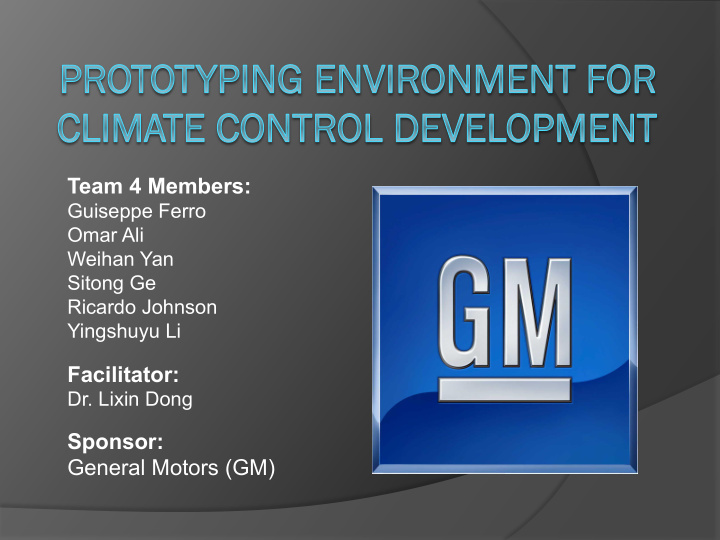



Team 4 Members: Guiseppe Ferro Omar Ali Weihan Yan Sitong Ge Ricardo Johnson Yingshuyu Li Facilitator: Dr. Lixin Dong Sponsor: General Motors (GM)
• Introduction • Objectives/Design Spec • Background • Local Interconnect Network (LIN) • dSPACE • Actuators/Sensors • Controller Designs • Project Timeline Projections • Questions?????????
• Why is climate control necessary? Chevrolet Volt User Interface
To accomplish climate control development, the following specs must be met: • Use dSPACE to: • implement a LIN handler • read various climate control sensors • drive multiple LIN actuators • Wire and demonstrate LIN device and sensor functionality using the dSPACE system. • Allow the customer to modify our driver design for reusability. • Document our design
• Why is digital communication better than analog? • What GM requires for the future of climate control • What we are doing to fix the problem
• LIN is a sub-bus system based on a serial communications protocol • LIN reduces cost by reducing the amount of wires handled, and components can be driven without crystal or ceramic resonators. • LIN also permits auto-correction in transmission and reception of data.
• Capture items in any format • Support all the development phases • Easy access to the materials • Preserves our digital work over the long term • Save on time and cost of prototyping
• Actuators • Air Inlet • Air Delivery • Temperature Blend Flaps • Blower Motor • Evaporator • Heater Core • Sensors • Rain, Light, Humidity sensor • Solar Sensor
Rain Light Humidity Sensor (RLHS) Solar Sensor
• Proportional Integral (PI) • Proportional Derivative (PD) • Proportional-Integral-Derivative (PID) PID Controller Simulink Diagram
January 13, 2014 February 2014 March (1-14) 2014 Gather all Project Overview Begin Virtual Design Materials March (1-14) 2014 March (16- 23) 2014 April 2014 Calibrate Final Begin testing virtual Build prototype design Prototype Design Day Display Final Design
Recommend
More recommend